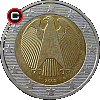2 euro GERMANY (2002-2004)


| diameter: | weight: | thickness: | alloy: |
| 25.75 mm | 8.5 g | 2.22 mm | Cu75Ni25/Cu75Zn20Ni5 |
obverse:
in the centre disk-shaped eagle - German Coat of Arms; below year of issue; at the edge a ring of twelve five-pointed stars - symbol of the European Union
reverse:
left from the centre face value: 2, on the right inscription: EURO; in the background of the inscription a simplified map of Europe showing borders of countries - members of the EU in 1999; in the background of the map vertically six parallel lines ending on both sides with five-pointed stars (the reverse is common for all euro coins)
edge:
reeded with concave inscription:
 (unity and justice and liberty and eagle from German Coat of Arms)
(unity and justice and liberty and eagle from German Coat of Arms)
 (unity and justice and liberty and eagle from German Coat of Arms)
(unity and justice and liberty and eagle from German Coat of Arms)
issue date:
1 I 2002
withdrawal date:
circulating
designer:
Heinz Hoyer, Sneschana Russewa-Hoyer, Luc Luycx (initials LL below letter 'O' in EURO on the reverse)
mint:
(A) Staatliche Münze Berlin (The State Mint Berlin), Berlin;
(D) Bayerisches Hauptmünzamt (The Bavarian Main Mint), Munich;
(F) Staatliche Münzen Baden-Württemberg (State Mints of Baden-Wuerttemberg), Stuttgart;
(G) Staatliche Münzen Baden-Württemberg (State Mints of Baden-Wuerttemberg), Karlsruhe;
(J) Hamburgische Münze (The Hamburg Mint), Hamburg
(relevant mint mark after the year of issue in the obverse)
(D) Bayerisches Hauptmünzamt (The Bavarian Main Mint), Munich;
(F) Staatliche Münzen Baden-Württemberg (State Mints of Baden-Wuerttemberg), Stuttgart;
(G) Staatliche Münzen Baden-Württemberg (State Mints of Baden-Wuerttemberg), Karlsruhe;
(J) Hamburgische Münze (The Hamburg Mint), Hamburg
(relevant mint mark after the year of issue in the obverse)
mintage:
| A | D | F | G | J | |
| 2002 | 238 920 000 + 135 000 * |
231 300 000 + 135 000 * |
281 090 000 + 135 000 * |
180 950 000 + 135 000 * |
257 820 000 + 135 000 * |
| 2003 | 20 470 000 + 140 000 * |
22 170 000 + 140 000 * |
24 460 000 + 140 000 * |
29 140 000 + 140 000 * |
19 500 000 + 140 000 * |
| 2004 | 31 570 000 + 140 000 * |
19 840 000 + 140 000 * |
- + 140 000 * |
- + 140 000 * |
22 510 000 + 140 000 * |
| 2005 | - + 100 000 * |
- + 100 000 * |
- + 100 000 * |
- + 100 000 * |
- + 100 000 * |
| 2006 | - + 90 000 * |
- + 90 000 * |
- + 90 000 * |
- + 90 000 * |
- + 90 000 * |
interesting facts:
In Germany it is allowed to modify the image of the eagle from the official Coat of Arms. Various institutions use therefore various designs of the eagle. The eagle shown on German obverses of euro coins is the most similar to the one designed for the German parliament (Bundestag) by Ludwig Gies in 1953. Geis' eagle was placed in the parliament in the contemporary German capital Bonn and today hangs in the parliament in Berlin.

photo licence: CC-BY-SA 3.0

photo licence: CC-BY-SA 3.0
last update: 3 XII 2014
coins catalogue :: katalog monet :: münzkatalog :: catalogue de monnaies :: catálogo de monedas :: catalogo monete :: каталог монет :: κέρματα κατάλογος :: COINZ.eu
© 2010-2025 :: Adam Kubicki :: COINZ.eu :: All rights reserved.


